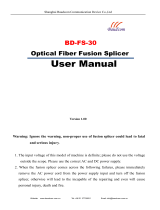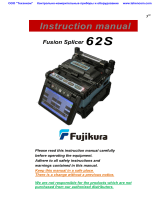Page is loading ...

Application Note
910FS Core Alignment vs Cladding Alignment Fusion Splicer’s
Introduction
The 910FS Core alignment fusion splicer provides lower loss fusion splices than cladding (V-Groove
technology) fusion splicer’s for several reasons. This paper will detail the technologies involved, loss
mechanisms and why core alignment splicers should be used for optimum splicing performance.
Core Alignment Technology
The typical splice loss for standard singlemode fiber using the 910FS Core Alignment splicer is 0.02dB
whereas for a cladding alignment splicer it is 0.05dB. This is not a big difference but this specification for
cladding alignment splicer’s is met under ideal and “new, out of the box” conditions.
The 910FS Core Alignment fusion splicer employs a Core Detection System (CDS) which is also known as a
Profile Alignment System (PAS). Essentially, light is shone into the fiber and embedded cameras are used to
identify the core of the fiber by detecting the difference in the refraction of light caused at the core/cladding
interface. The type of fiber is also determined at this time and allows the 910FS fusion splicer to
automatically select the optimum splicing profile.
Core alignment splicer’s use six motors and two cameras to align the fibers in the X, Y and Z dimensions.
The 910FS Core Alignment Splicer is able to compensate for any misalignment of the fiber cores held in the V-
Grooves since the V-Grooves are actually moved so that the centres of the cores of the both fibers are
precisely aligned. This is done in a dynamic feedback loop (PAS) methodology that automatically senses the
active area of the fiber core and adjusts the alignment of the two cores to minimize splice loss.
Any misalignment of the fibers within the two V-Grooves, due to fiber tolerances, contamination or damage
to the V-Grooves is automatically compensated for resulting in repeatable, low loss splices.
That said, we must remind the splicing technician to be diligent with the care and maintenance of the splicer
but the active alignment system allows the technician to use the splicer in real life situations while obtaining
low loss splices quickly and reliably.
Cladding Alignment (V-Groove) Technology
While this technology is lower cost there are many compromises that reduce its effectiveness in the “real
world”. A cladding alignment splicer generally uses one camera and two motors and relies on the two V-
Grooves to be perfectly aligned and the concentricity of the outside of the fiber cladding to align themselves
in the X and Y axes before the motors bring the fibers together along the Z axis for splicing.
Causes of Fiber Misalignment in V-Groove Splicers
The cores are not in the dead centre (Co-axial) of the cladding.
Cladding diameter mismatch, especially from different fiber manufacturers.
Dirt in the V-Groove will misalign the fibers.
Misalignment or damage of the V-Grooves themselves.
The active alignment mechanism of the 910FS Core Alignment splicer makes adjustments to compensate for
concentricity, diameter variances and contamination from dirt and dust, thus producing lower loss splices.

Concentricity
Single Mode Fiber (SMF) has a core diameter of between 8 and 10 microns but if the core is not in the
geometric centre of the fiber cladding, a mechanical alignment of the cladding (in V-Grooves) can’t optimally
align the cores in the X and Y dimensions. This results in higher splice losses. This problem is further
compounded when fibers from different manufacturers are spliced since the cores may be in slightly different
positions.
Cladding Diameter Tolerance
If the user is splicing fibers from two different manufacturers, the actual diameter of the fiber claddings may
also be slightly different. The smaller diameter fiber will sit slightly lower in the V-Groove than the other
resulting in further misalignment and therefore higher splice losses.
Courtesy: Corning Inc
Dirt and Dust
Further compounding these problems is the fact that if the V-Groove is dirty or the cladding of the fiber isn’t
fully cleaned then the fiber will not rest in the proper alignment position. If the fiber or the splicer is
contaminated with dust or dirt, the resulting splice will be subject to higher losses or even failure for the
splicer to complete the splice.
It is impossible to eliminate all dirt and dust where splicing is performed but the technician has a
responsibility to clean and care for the splicer as recommended by the manufacturer. Doing so will yield
lower splice losses and increase the lifetime of the splicer.
Non Concentric core
Dirt in V-Groove
V-Groove Misalignment
Should the V-Grooves become damaged (chipped or scored) over the course of time due to use, improper
cleaning and neglect, the relative alignment of the V-Grooves may become compromised and higher splice
losses will occur.
Summary
The 910FS core alignment fusion splicer:
Consistently makes lower splice losses.
Uses dynamic Profile Alignment System (PAS) to minimize splice losses.
Is more tolerant of real world splicing environments.
Proper care and maintenance of the 910FS fusion splicer will maximize splicing performance.
/




